
On August 16, a significant event occurred in the cryptocurrency world. A mysterious address numbered 19D5J8 suddenly became active after five years of dormancy, transferring 3,000 bitcoins worth up to $353 million at current prices. The last activity of this address was in 2020 when bitcoin was only around ten thousand dollars. Five years of waiting resulted in a return of several multiples.
On-chain data tracking indicates that this address initially accumulated bitcoins between 2017 and 2019, coinciding with the first bull market. The buying cost at that time may have been only a few thousand dollars per bitcoin, and the current return has reached astonishing levels. Even more intriguing is the timing of the transfer. Bitcoin is at a critical position near $120,000, and there is a significant divergence in the market regarding whether it can break the historical high. At this sensitive moment, every move of the whales could influence market trends.
This large transfer has sparked various speculations. The most straightforward explanation is profit-taking; after all, holding for five years has already yielded substantial returns, making it reasonable to cash out at a high point. However, it may also involve strategic asset reallocation, such as transferring to a safer cold wallet or preparing to participate in other investment opportunities. With a large influx of institutional investors, some early individual holders may choose to reallocate their assets through institutional channels.
The behavior of giant whales often serves as a barometer. Historically, the sudden activation of long-dormant addresses typically indicates that significant changes are about to occur in the market. These early investors possess more market information and a keener sense of smell, and their actions often reflect market trends in advance. A scale of $353 million is sufficient to significantly impact market liquidity; even if these bitcoins are not immediately sold, market sentiment will fluctuate as a result.
This event has also prompted a reevaluation of the distribution pattern of bitcoin. Currently, about 2% of addresses control 95% of the bitcoin supply, and this highly concentrated distribution has always been a concern for the market. The actions of whales can disproportionately impact prices, which is one reason for bitcoin's high volatility.
For ordinary investors, the actions of giant whales provide valuable market information, but they should not be the sole basis for investment decisions. Whales have a stronger risk tolerance and more insider information, and their strategies may not be suitable for the average person. More importantly, it is essential to develop an appropriate investment plan based on one's own risk tolerance rather than blindly following trends. In this unpredictable market, maintaining independent thought is always more important than following the big players.


